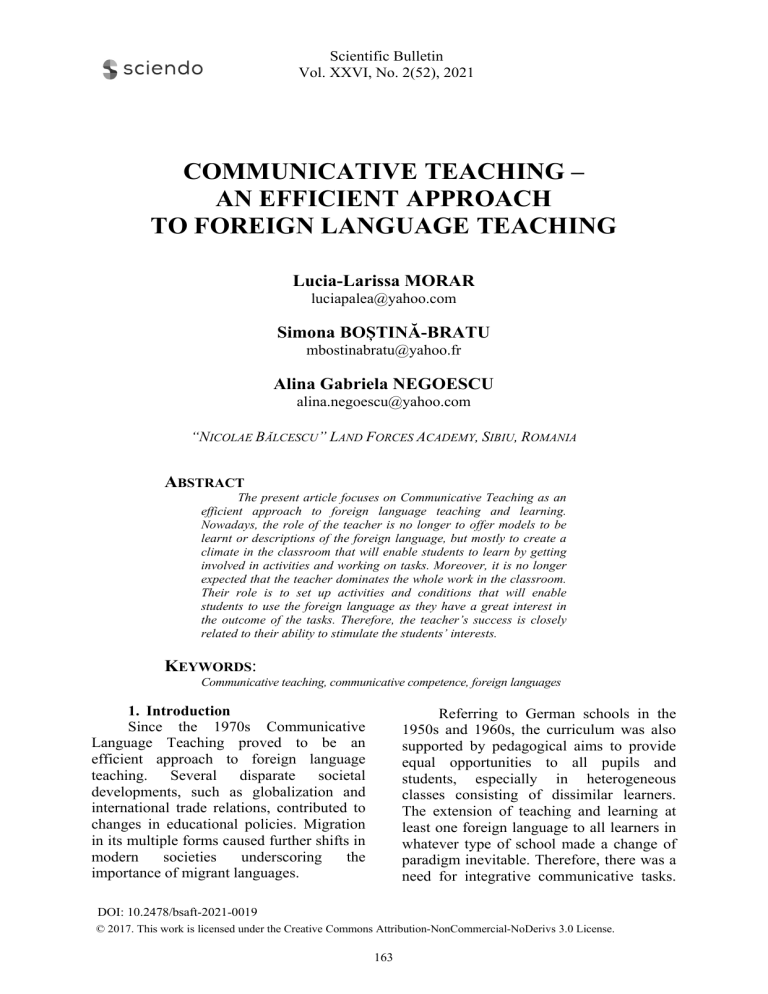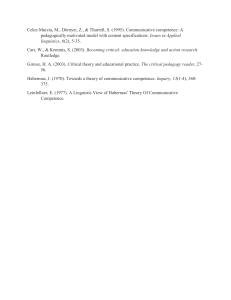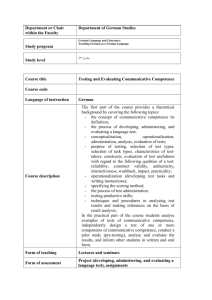Communicative Teaching - An Efficient Approach to
advertisement

Scientific Bulletin Vol. XXVI, No. 2(52), 2021 COMMUNICATIVE TEACHING – AN EFFICIENT APPROACH TO FOREIGN LANGUAGE TEACHING Lucia-Larissa MORAR luciapalea@yahoo.com Simona BOȘTINĂ-BRATU mbostinabratu@yahoo.fr Alina Gabriela NEGOESCU alina.negoescu@yahoo.com “NICOLAE BĂLCESCU” LAND FORCES ACADEMY, SIBIU, ROMANIA ABSTRACT The present article focuses on Communicative Teaching as an efficient approach to foreign language teaching and learning. Nowadays, the role of the teacher is no longer to offer models to be learnt or descriptions of the foreign language, but mostly to create a climate in the classroom that will enable students to learn by getting involved in activities and working on tasks. Moreover, it is no longer expected that the teacher dominates the whole work in the classroom. Their role is to set up activities and conditions that will enable students to use the foreign language as they have a great interest in the outcome of the tasks. Therefore, the teacher’s success is closely related to their ability to stimulate the students’ interests. KEYWORDS: Communicative teaching, communicative competence, foreign languages 1. Introduction Since the 1970s Communicative Language Teaching proved to be an efficient approach to foreign language teaching. Several disparate societal developments, such as globalization and international trade relations, contributed to changes in educational policies. Migration in its multiple forms caused further shifts in modern societies underscoring the importance of migrant languages. Referring to German schools in the 1950s and 1960s, the curriculum was also supported by pedagogical aims to provide equal opportunities to all pupils and students, especially in heterogeneous classes consisting of dissimilar learners. The extension of teaching and learning at least one foreign language to all learners in whatever type of school made a change of paradigm inevitable. Therefore, there was a need for integrative communicative tasks. DOI: 10.2478/bsaft-2021-0019 © 2017. This work is licensed under the Creative Commons Attribution-NonCommercial-NoDerivs 3.0 License. 163 speech act theory, and focused on the importance of performance and of sociocultural factors. The interrelated and multiple developments led to what is called the Communicative Turn (in German “kommunikative Wende”). So, teaching and learning foreign languages could no longer be based on structural approaches that allowed at best for prefabricated utterances or memorized patterns with minimal reference to realworld communication. The Communikative Turn in Germany is related to Hans-Eberhard Piepho and his publication Kommunikative Kompetenz als übergeordnetes Lernziel im Englischunterricht (Communicative Competence as a Superordinate Learning Objective in English Classes). Piepho’s approach is based on Jürgen Habermas’ work, Habermas being one of the most important social philosophers of the 20th century. In 1971 he published an important article entitled Vorbereitende Bemerkungen zu einer Theorie der kommunikativen Kompetenz (Preliminary Remarks on a Theory of Communicative Competence) which he elaborated years later in his twovolume scientific work Theorie des kommunikativen Handelns (A Theory of Communicative Action). According to Habermas (1984) the term communicative action is composed of two interrelated domains: communicative action in the sense of interactional practices and discourse, as the metacognitive negotiation of meaning. This distinction has a great impact on foreign language teaching. Nowadays, changes similar to those in Germany are observed in the English speaking countries internationally interrelated, mainly between German and English pupils and students. The most important representative that no longer conceived language as an innate and mostly invariable system, but connected it to social action was Dell Hymes in the USA. He disseminated his approach contrary to Noam Chomsky’s Universal Grammar and the Language Acquisition Device. Hymes drew on the results of pragmalinguistics, especially on 2. Communicative competence and communicative foreign language teaching Contemporarily, communicative competence is more and more extended leading to intercultural discourse competence. Discourse competence comprises the ability to produce appropriate, correct and understandable texts and messages (Kaufmann, Zehnder, Vanderheiden & Frank, 2012). The language user has to take into account principles of cohesion and coherence. Whereas cohesion underscores the necessity of paying attention to formal aspects of the relationship sentence-text / message, coherence refers to aspects of text / message content and their interdependence. As far as the multiple intercultural connections in a world of digitalization and internalization are regarded, the concept has been extended to Intercultural discourse competence, one of the most important objectives of teaching and learning foreign languages. Moreover, foreign language teaching contributes to the improvement of intercultural communication. Nowadays, communicative competence comprises four competences: • Sociolinguistic competence implies the ability to establish social relationships and shape them adequately. Moreover, it comprises the faculty to choose the appropriate speech register and to recognize language varieties in communication (Huesmann, 2020); • Pragmatic competence refers to skills and knowledge that are necessary for a functional and adequate discourse in order to reach one’s own communicative objectives and to understand those of others (Vielau, 1997); • The ability to plan, carry out and evaluate and to a certain extent remove communication obstacles, such as misunderstandings (Canale & Swain, 1980); 164 So far, we have examined the theoretical part of Communicative Foreign Language Teaching. Now, we are going to shed a more practical light on the already discussed approaches by presenting some tasks that we have been using during our English, German and French classes with our students. We started by showing the students a map of a city on which the buildings and other landmarks were colourful pictures cut out from illustrated magazines. The map looked attractive as it served as a background to a series of activities that followed during the next classes. The activity regarded giving and following directions. Students were divided into A and B and had to work in pairs. They got copies of city maps of the same area, but different places had been labelled on the maps they received. For example, student A had the restaurant, the bank, the pet shop, etc. marked on his / her map. Student B had the hotel, the university, the cinema, etc. marked on his/her map. In preparing the master version, the teacher would have to spend some time figuring out which place goes to which map. The students were informed that they were a group of international students who had come to this English / German / French city for two days and wanted to see and hear as much as possible. During the activity the students had to play the parts of both the tourists and the residents. All the A students got the following instructions with their map: “Ask a local resident (student B) how to get from the bridge to the places listed below (hotel, university, cinema, etc.). Write the names in the right places on the map”. After all the necessary directions had been given, students B played the roles of the tourists and asked for the restaurant, the bank, the pet shop, etc. After giving directions, which did not take much time, the tourists got together in the hotel lounge. At this stage the teacher could check the correctness of all the places marked on the students’ maps. The activity continued with students A being “local residents”, while • It is essential to underscore linguistic competence in order to avoid the recurring misunderstanding that Communicative Language Teaching neglects correctness. The ability to participate in target language communication means being able to produce (mostly) correct (oral or written) messages or texts regarding grammar, phonology, lexicology and semantics. Although these competences can be trained separately, Communicative Language Teaching aims at integrating them in activities and tasks suitable to promote intercultural discourse competence. The changes of perspectives mentioned above did not only entirely transform procedures of teaching and learning, but radically changed the content of teaching and learning materials, such as grammars, workbooks and textbooks. Communicative Language Teaching is a broad approach to teaching foreign languages, in our case English, German and French, characterized by a wide spectrum of teaching methods and learning strategies. Beside its focus on the learner from different perspectives, Communicative Language Teaching aims at establishing connections between the language taught in the classroom and its use outside the classroom in real-life situations. An important list of features and principles of Communicative Language Teaching was established by the Australian linguist David Nunan. Four of the most important features are: • The introduction of authentic texts in the foreign language class; • An emphasis on learning to communicate by means of interaction in the target language; • An attempt to link classroom language learning with activities outside the classroom; • An enhancement of the students’ own personal experiences as important contributing elements to classroom learning (Nunan, 1991, pp. 279-295). 165 the students’ creativity and desire to work together. The teacher should also write down observations on the students’ reaction to the activities, their involvement, degree of motivation and the language they have used. students B were tourists who had come to visit towns in England / Germany / France. The “local residents” had to tell the visitors three facts about their country. Afterwards, the students switched places and students B had to tell students A three facts about the country they represented. Subsequently, students were engaged in different activities and games. They worked in pairs or groups of three, depending on the size of the class and available time. The teacher informed the tourists that they could go to any place in the city and do whatever they liked. In choosing places to go, the teacher could decide whether the tourists would draw cards with place names and instructions to carry out, or whether they could really go where they wanted to. The upcoming activity had the following instruction: Go to the local art museum to see an exhibition of a famous photographer. Describe the pictures that most impressed you. Five or six interesting photographs from magazines had been prepared and put in an envelope. The task for the next activity was the following one: You have decided to go to the university and talk to the students in the English / German / French department. Ask them about their studies, recreation, etc. Finally, the students told the entire class what they had previously found out about English/German/French students. As an assignment, the students got the following task: Go to the local art museum to see an exhibition of a famous photographer. Write a text for an imaginary brochure including information about the photographer. An imaginative teacher can think of many other ways to diversify the learning experiences consolidated in this context. Pictures, slides, stories, questionnaires and quizzes can be easily incorporated into the activity. There is no need to do everything in one lesson / class. The aim is to stimulate 3. Conclusions Communicative Foreign Language Teaching has been influenced by many different societal developments that have had a notable impact on education policies, pedagogical norms and the practice of teaching foreign languages. Beyond grammatical and lexical correctness students have to be aware of the fact that foreign languages have to be appropriate for social contexts. Thus, their use of English, German or French is to be linked to communication outside the classroom, which means that teachers prepare their students for the observance of sociolinguistic norms. Therefore, teachers provide their students with o variety of language experiences, a task that has become easier with the help of digital media. Foreign language teachers have to plan and prepare the lessons taking into consideration the interests and needs of their students. It is no longer appropriate any more to open the course- or workbook at the pages dealt with during the previous lesson. The teachers’ knowledge of and their experience with their students enable them to choose reachable and desirable objectives. Furthermore, with the participation of the students, content and texts, learning strategies and techniques as well as pair work learning or small group work are conceived. In conclusion, Communicative Foreign Language Teaching is a basic principle of learning foreign languages bringing together different competences based on content, activities and projects that enable students to discover, reflect and verbalize what is really relevant and worth discussing. 166 REFERENCES Adler, A. (2002). Kommunikativer Ansatz, Hausarbeit. Available at: https://www.grin.com/document/22954 accessed on 28 October 2021. Canale, M., & Swain, M. (1980). Theoretical Bases of Communicative Approaches to Second Language Teaching and Testing. Applied Linguistics, Vol. 1, 1-47. DOI: 10.1093/applin/I.1.1. Huesmann, I. (2020). Kommunikationskanäle für den Austausch im Unterricht. Available at: https://www.researchgate.net/publication/343764250_Huesmann_2020_ Kommunikationskanale_fur_den_Austausch_im_Unterricht. Hymes, D.H. (1971). On communicative competence. In J. Pride & J. Holmes (Eds.), Sociolinguistics. Penguin, 1972 (Excerpt from the paper published 1971, Philadelphia, University of Pennsylvania Press). Kaufmann, S., Zehnder, E., Vanderheiden, E., & Frank, W. (2012). Fortbildung für Kursleitende Deutsch als Zweitsprache. Ismaning: Hueber Verlag. Littlewood, W. (2010). Communicative Language Teaching. New York: Cambridge University Press. Nunan, D. (1991). Communicative Tasks and the Language Curriculum. Tesol Quarterly, Vol. 25, Issue 2, 279-285. Nunan, D. (2017). Research Methods. In: Byram, M., & Hu, A. Routledge Encyclopedia of Language Teaching and Learning. (593-598). New York: Routledge. Piepho, H.-E. (1974). Kommunikative Kompetenz als übergeordnetes Lernziel im Englischunterricht. Dornburg- Frickhofen. Vielau, A. (1997). Methoden des kommunikativen Fremdsprachenunterrichts. Berlin: Cornelsen Verlag. 167



